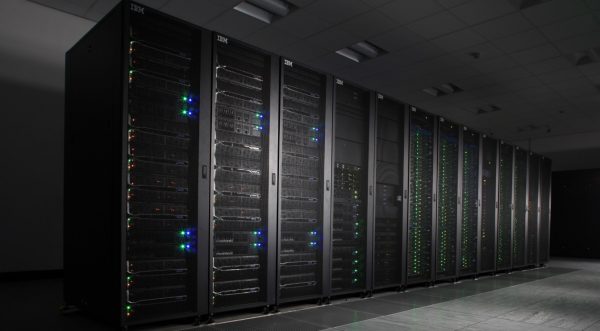
Watson on Power 9
This keynote looked at AI’s progress in cultivating new knowledge in the enterprise and in transforming critical industries like healthcare, telecommunications and financial services. IBM’s Dr. John Kelly and David Kenny and special guests examined the underlying complexities of developing new AI technologies and how forward-thinking leaders are using AI to reimagine workflows within their professions and industries.
Moores Law: just put 10 billion transistors on a power 9 chip
Metcalfs Law: network volume created huge companies
Watsons Law: data is doubling every 12-18 months. Extracted knowledge will scale knowledge and accelerate learning.
But first the grounding on AI. Organizing your pictures is “easy” AI. The other extreme is general AI where it can do almost everything. That’s 30-40 years out before you can even approximate it. Broad artificial intelligence can take unstructured, disparate forms of data and gain insight from it.
AI has to be with you and in your context in order to provide value. So getting the data analyzed is only half the problem.
Fact: 80% of the worlds data is locked up and not searchable
Every industry will not only be impacted but completely transformed.
Where will it run?
IBM developed Power 9 to get 4X better AI power. There are ways to accelerate machine learning and intelligence beyond faster processors. Graphics processors bring unique capablities to AI.
Announcement: Nvidia is an IBM partner to accelerate AI. Putting Power9 and Nvidia GPU’s will get a 50X improvement in ability to ingest data and analyze it.
Jensen Huang of Nvidia
IBM and Nvidia worked on Playstation 3, Government supercomputers, etc. The Power 9 is the most advanced processor in the world. Summit and Sierra are the first supercomputers which directly connect the CPU and the GPU. This architecture is the industry standard for deep learning scientists.
With deep learning, you can use software to write software. Nvidia has invested about $10B in deep learning and AI.
Questions: what are some of the areas you are investing in.
Answer: Mission #1 is to develop the processors to handle AI. Yesterday we announced a brand new graphics processor called ray tracing. This was a combination of both GPU and deep learning algorithms. One of the applications here is self-driving cars.
Without modern AI, self-driving cars would be nearly impossible to solve. This is an application where peoples lives are at stake. Jensen showed a Nvidia self-driving car video outlining all that’s happening.
Future: Every company will have these types of supercomputers in their data centers
What do we do:
- Collect data
- Train models: Need high performing computers to do this.
- Simulate: Need to do VR to get the training to a level of billions (vs millions) of miles
- Drive
Watson In Health Care
Gary Ready, American Cancer society
Craig Thompson, MD of Memorial Sloan Kettering
Fact: over 500,000 people will die from cancer each year
Craig: Cancer is a complex disease and it gets more complex each year. Today cancer is really over 200 diseases and we need to understand all of them. Patients and doctors need the most up to date information. We need that delivered at the point of contact. Our physicians have worked with Watson to train it on each sequential cancer. Today Watson Oncology is being used throughout the world. 10,000 patients are using it. That also gives Watson even more data to develop the best possible algorithm.
IBM: Craig wrote the book on the biology of cancer. With Watson, he’s not writing the book anymore.
Gary Ready: American Cancer Society is excited about Watson and power of AI. The best care is at a major teaching center like Memorial Sloan Kettering but that’s just not possible. We believe that where you live should not determine if you live. That’s where Watson comes in.
Outside the US, even more challenges exist. We’ve developed the cancer care navigator to help oncologists in developing countries. It makes recommendations and shows the publication source. Some countries only have four or five oncologists. They cannot be a specialist.
IBM: We find that Watson finds about 30% more options for treatments. When do you think there will be a tipping point where Watson is demanded by the patients.
Craig: We are blessed in the US to have a reasonable # of oncologists. 100 to one. Africa has 10,000 to one. We are seeing the largest take up in Asia and Eastern Europe where the average ratio is 1,000 to one. That pushes rapid uptake where the oncologist is enabled. We think the US will reach the uptake point in the medium term.
Gary: It’s not man vs machine. It’s man and machine. As more Oncologists feel comfortable using Watson as a second opinion. As more understand this then more will start demanding it.
IBM: only a small number of people in India can afford this so it’s inclusion as well.
Craig: We want this to be available to everyone in the world. We can now sequence a small part of your genome and that helps molecular biology. It helps us understand the different risks associated with cancer. Sloan Kettering has a Watson Genomics projects to reach out to the diverse DNA of New York to understand this even better. Ultimately this will drive down the cost. Cancer can be a survivable and curable disease.
